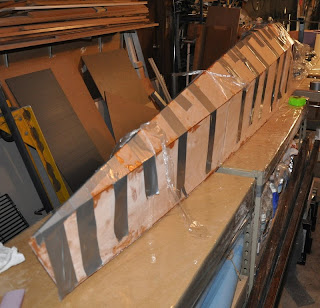Topside Taped
On a very chilly Saturday the top side of the boat was taped and sealed. Bits and pieces of cloth were draped over the cockpit at 45 degrees to the weave, measured and cut to fit. Other pieces were measured to cover the cockpit floor and seams. The edges of the wooden panels were rounded one last time with a sanding block to provide a couple of millimeters of radius to allow the cloth to follow surface. All dust and glass threads were vacuumed away.
The wooden fillets were checked for fit. One had to be sanded a bit at the end to fit against the deflector plate, which apparently moved somewhat forward when it was glued in place.

I started with applying resin to the top of the torque box first, followed by its sides and the cockpit floor. Using a cheap sponge brush I coated the wooden fillets on all sides and put them in place along the floor and the wooden bulkhead against the torque box.
The glass cloth was then laid on top of the fresh resin. Oops - not quite the right spot. Grr! Now it was shrinking in width, too!
Yes, the 45 degree cut allowed the cloth to stretch in length, which also caused it to shrink in width. Just lifting the cloth was enough to stretch it in length. The cloth had to be pulled wider and then applied to the sticky surface.
This repeated over and over. I figured that I'd be happy when I got to the rear deck where I had 90 degree strips prepared.
Anyway, it was taking a long time to get the cloth strips to nicely cover the seams of the cockpit area, and the cheap sponge brush was self destructing. Sigh...


Fortunately, my daughter arrived to provide assistance. I gave her a filter mask and rubber gloves and put her to work on the other side of the cockpit.
Working together we managed to get all the glass wetted out. My daughter progressed to gluing the deck seams and I finished up the cockpit.
At this point my daughter had other things to do so I bid her adieu and thanks for her help.
The rest of the front deck was covered in resin.
I took a piece of 12 oz 45 degree cloth, laid it flat on the plastic covered workbench and poured resin on it, letting it sit for a few minutes. The resin spread throughout the glass, saturating it nicely with no work on my part.
Picking it up carefully I then wrapped it around and over the bow.

Using shrink wrap plastic, pressed in place with foam rubber clamped between two boards, the glass was pressed against the wood hull. This was the same technique as used for the stabilizer bow and stern.
The next step was to tape and glass the rear deck. For this I had 90 degree cloth strips cut and applied. This seemed to work OK at first, but soon I noticed that the cloth was not staying flush against the surface near the edges. Rats! The edge was too sharp!
Just at this point my wife arrived and asked if she could help. Yes, certainly!
Giving her the roll of 6 oz tape I asked her to cut 4 to 5 inch strips of the cloth on a 45 degree bias. She took it to a warm part of the house, laid it on a large cutting table, and quickly cut it to size with a rotary cutter. This was much faster and cleaner cutting than with a scissors.

I removed the strips that I had placed on the rear deck, replacing them with the new bias cut pieces. Voila! The new pieces were much better behaved. Thank you, wife!
The stern was wrapped in 12 oz glass just like the bow, and also clamped in place.
The last step was to apply 6 oz cloth to the seat area. The piece was just a little too big, so short threads stuck over the edge. I think they will sand off fairly easily later.

The whole process took about 4-1/2 hours.
I'm now into the second gallon of resin.
Yes, the odor from the resin was what gave me headaches. With the very chilly weather (0 degrees C) we have been having I didn't want to open the garage door to ventilate. Instead, I used a wimpy exhaust fan I installed years ago that sucks air through a movable clothes dryer duct. Yes, it helped a bit, but after a while I decided to open the garage door anyway. It got pretty cold, and after a couple of hours of work the resin was not working quite as well - so I closed the door again. The resin is supposed to work down to 35 degrees with the fast hardener, so perhaps it reached that temperature.

I took off my work outer garments (thick cotton Army jacket, moderately thick jacket, thick inner cotton work shirt and shoes, and left the house after finishing the taping and took the family out to dinner, leaving the exhaust fan running all night.
Sunday morning I woke with a light version of the same headache as before. Yup - got to make sure there is adequate ventilation!

































